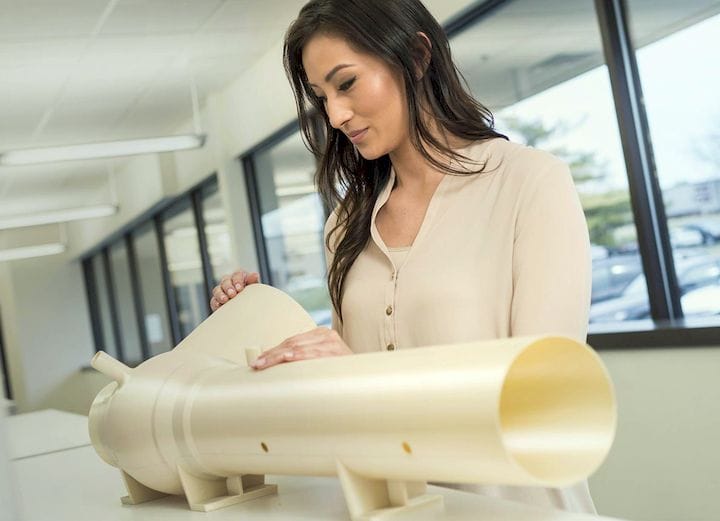![New equipment at Stratasys Direct Manufacturing [Source: Stratasys Direct Manufacturing]](https://fabbaloo.com/wp-content/uploads/2020/05/image-asset_img_5eb09893e472e.jpg)
Stratasys announced some new equipment at their 3D print service, but what does it mean?
Stratasys Direct Manufacturing is the company’s service bureau, where requests from clients to produce prints are handled. We visited their factory some years ago and found it to be an impressive operation. At the time their machine floor was populated with a number of Fortus machines, as one would expect: Stratasys makes them!
![An array of production 3D printers at Stratasys [Source: Fabbaloo]](https://fabbaloo.com/wp-content/uploads/2020/05/stratasys-direct-manufacturing-farm_result_img_5eb0989449070.jpg)
In addition to the Fortus equipment, there were a number of post-processing technologies in use. We were told them that they intended to branch out into a number of different manufacturing technologies, beyond 3D printing.
![Postprocessing FDM 3D prints at Stratasys [Source: Fabbaloo]](https://fabbaloo.com/wp-content/uploads/2020/05/stratasys-direct-manufacturing-postprocessing_result_img_5eb0989493bbf.jpg)
That strategy seems to have been executed as today they offer a variety of services, including:
-
3D printing
-
Urethane casting
-
CNC machining
-
Injection molding
-
Design services
Their 3D printing segment, as you might expect, includes thermoplastics produced by Stratasys’ own FDM and PolyJet technologies. But what might not be obvious is that this Stratasys operation provides 3D printing with competitive technologies as well as their own.
This is evident from an inspection of the technologies listed on their website, where they mention, for example, laser sintering. This is a technology that is not on Stratasys’ product list. They don’t explicitly say, but the SLS technology is likely provided through EOS equipment. Similarly we also see they list Multi Jet Fusion. MJF is provided by HP, one of Stratasys’ key competitors.
Now we learn they’ve swung a deal to include a metal 3D printing technology in their service along with the others. This time they’ve partnered with newcomer VELO3D, a previously mysterious California-based startup that has developed a rather powerful metal 3D printing technology suitable for manufacturing.
We’ve written previously about VELO3D, but the gist of their technology is that like many others, it is a powder bed/ laser fusion process, but with substantial improvements. Basically, they’ve instrumented the heck out of their devices to provide extreme control and thus achieve very high-quality results.
This sounds like a terrific development for users of Stratasys Direct Manufacturing, but what does the existence of this service and their partnerships really mean for Stratasys itself? I have some ideas.
Reliable Sales: Certainly one of the major equipment components at Stratasys Direct Manufacturing is Stratasys equipment. Thus they have a service bureau regularly and reliably purchasing large quantities of 3D printing equipment from the mother company.
Quality Feedback: by using their own equipment and materials at scale, Stratasys is able to constantly obtain highly relevant feedback about all aspects of the machine and the materials used in them.
Extra Revenue: As far as we know, this operation is quite profitable and thus it would be a positive to Stratasys’ bottom line.
Competitor Deflection: Stratasys has one of the larger networks have resellers, and thus they have very significant contact with many clients. These connections enable potential capture of print requests that can be routed to their own service operation, rather than allowing them to escape to a competitive operation.
Deeper Client Understanding: By working directly with clients on manufacturing projects, Stratasys can learn much more deeply about the needs of their clients. This knowledge will no doubt feed back to the mother company for use in the development of future products.
Exposure to Competitors: As mentioned above, Stratasys Direct Manufacturing offers the use of competitive equipment. This allows Stratasys to become intimately familiar with the capabilities and operation of other types of equipment they might consider competing with in the future. Again, this is good knowledge for future product development — or even making decisions to not embark on the development of competitive products.
Metal Experience: Finally, we keep hearing about Stratasys intending on entering the metal 3D printing market and they’ve even made some announcements to this effect. As this is a highly competitive market, it seems a reasonable they should obtain direct experience in performing metal 3D printing operations, even with competitive equipment.
In all, it seems to me that Stratasys Direct Manufacturing is a very strategic move by Stratasys.
Via Stratasys Direct Manufacturing











The debate over use of proprietary or open materials ecosystems is becoming a big topic in 3D printing.